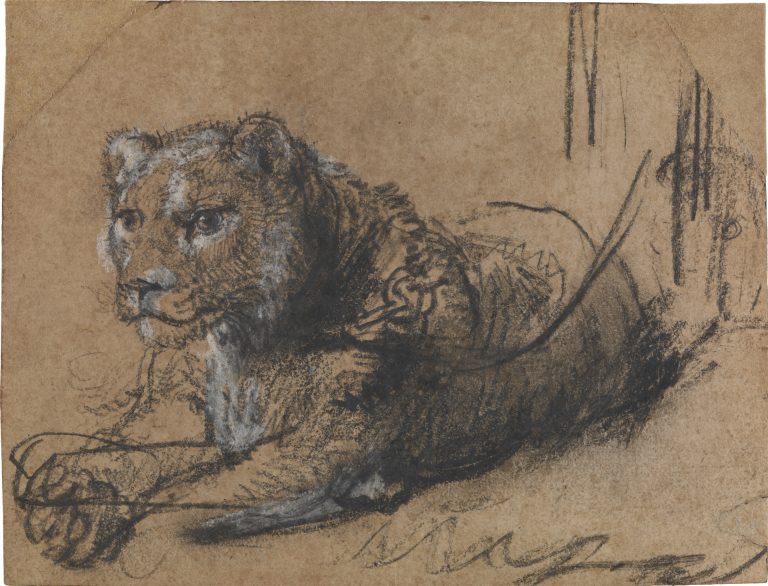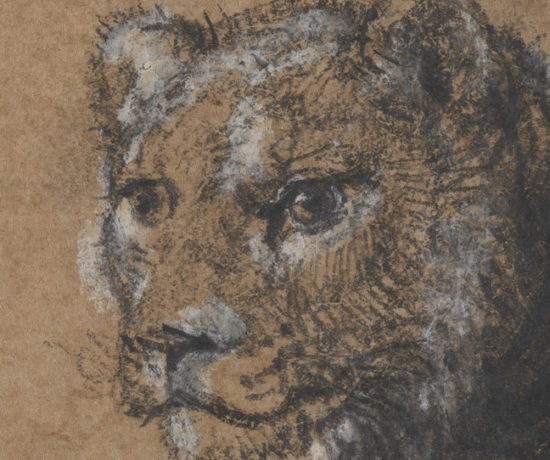Young Lion Resting belongs to a group of three powerful drawings of the same beast closely related in style and technique that Rembrandt van Rijn executed in the late 1630s. The other two drawings of this lion are in the British Museum (fig 1) and (fig 2).1 In both of those drawings Rembrandt depicted the lion from the side, whereas he drew Young Lion Resting in three-quarter profile.2 In each of these drawings Rembrandt carefully worked up the head of the young lion in a similar manner, and in each he captured a sense of the animal’s inner life by accentuating the eyes with firm strokes. He also discretely applied gray washes to draw the viewer’s attention to the beast’s head and forequarters. Slight differences among these drawings, however, do exist. Rembrandt rendered the bodies of the London lions in graceful, evocative lines, whereas in the Leiden Collection drawing contour lines give the animal its final form. The master used similar lines to alter the position of the forepaws.
Despite their remarkably similar appearance, Rembrandt may have used somewhat different materials to make these drawings. Marjorie Shelley, paper conservator at the Metropolitan Museum of Art in New York, has determined that for Young Lion Resting Rembrandt used black chalk modified with oil or black chalk with a high clay content, as well as white chalk and gray wash applied with the brush.3 Martin Royalton-Kisch has concluded that Rembrandt drew the lions in the British Museum with charcoal and gray wash,4 while Jeroen Giltaij believes he used black chalk.5
North African lions were brought on ships of the Dutch East India Company to the Netherlands, where they were kept in menageries and shown at fairs.6 Among the various animals Rembrandt drew, lions intrigued him the most. In addition to his drawings of other animals—including horses,7 elephants,8 pigs,9 and birds of paradise10—six autograph drawings of lions are known, including one at the Louvre (fig 3) and the aforementioned two at the British Museum.11 He drew these animals to acquaint himself with their appearance and character, so that later on he could portray them from the imagination. For example, he included an elephant in the background of an etching of Adam and Eve, 1638,12 after having drawn the animal from life a couple of times the previous year. Rembrandt’s representations of Saint Jerome in the wilderness always contain a lion, but the animal in his etching of 163413 is vastly different in appearance from the lion he depicted in these drawings, which date a few years later. This difference in portrayal before and after Rembrandt had seen actual lions emerges clearly in the etching Saint Jerome in an Italianate Landscape of ca. 1653.14
Rembrandt’s drawings of lions also served as examples for his pupils. Not surprisingly, drawings of lions by pupils and followers of Rembrandt have sometimes been wrongly attributed to the master himself.15 Constantijn van Renesse (1626–80), a pupil of Rembrandt around 1650, made a drawing with lions based on those drawn by his teacher in a portrayal of Daniel in the Lions’ Den.16
Young Lion Resting and the two London drawings are usually connected with Rembrandt’s grisaille in Rotterdam, The Unity of the Country.17 In this detailed composition, a chained lioness lies below the coat of arms of the city of Amsterdam. This design for a political print has been given dates that range from ca. 1637 to 1642.18 The inscribed date on the painting—164.—indicates that Rembrandt finished it in the 1640s, though it is impossible to be more precise because the last digit is no longer visible. Dendrochronological examination has shown that the painting is executed on a panel from the same tree as the support of a painting in Washington D.C., Portrait of a Polish Nobleman, dated 1637.19 It is possible that these three drawings inspired Rembrandt’s depiction of the lion in the Rotterdam painting, which would suggest a date for the three drawings of about 1637.20
Drawings of animals were listed separately in Rembrandt’s inventory of 1656: “A ditto [art book] full of drawings by Rembrandt, consisting of animals [drawn] from life.”21 The art dealer Jan Pietersz Zomer (1641–1724) owned 19 drawings of lions by Rembrandt that were recorded in the catalogue of his collection compiled in about 1722.22 Rembrandt’s Recueil de Lions, engraved by Bernard Picart (1673–1733) and published in Amsterdam in 1729, contained eighteen lions—perhaps the same as those published by Zomer. The two previously mentioned drawings in London both figure (in reverse) in Picart’s lion series.24 The 1800 sale catalogue of the collection of Cornelis Ploos van Amstel (1726–98) also lists 14 lions.25 Drawings of lions were exceptionally popular, as is evident from the numerous copies made after them.

